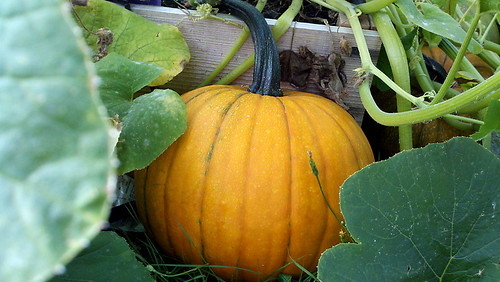In the photo you can see some of the dreaded powdery mildew spots on last years upper pumpkin patch. A big problem here in Oregon so I tried the powdery mildew resistant seeds last year. For the most part it worked until we had some damp weather set in and then it was still hard to fight. Still less mildew than regular seed planted in 2011. A pretty good haul from two 4X4 raised beds with 14 larger pumpkins and several smaller pumpkins. I had to hand pollinate the upper bed as the bees were few.
Ordered my seeds from Johnny's Selected Seeds. They just arrived and I'm excited about trying new baby white ghost pumpkins in the mix. New Racer will be planted for a second year and along with Charisma. They are similar in size and yielded nice 8-12 pound larger pumpkins and the smaller ones were around 3-5 pounds. This year I'm using only drip lines in the beds and made sure the second bed was up wind from the sprayers used in the lower part of the garden. That might have been an issue last year with over spray on the lower patch.
Thursday, June 13, 2013
Pumpkin Patch Planning 2013
Subscribe to:
Post Comments (Atom)
Lucrezia
New grave this year. This one is heavy. Storing it for the year I was crawling around on a raised shelf section of the basment trying to...

-
New grave this year. This one is heavy. Storing it for the year I was crawling around on a raised shelf section of the basment trying to...
-
This was the neighbor down the streets 12 ft skeleton display. The costumes were hand made. A really beautiful display. I to...
-
Found this lovely project here . Scroll through her blog to see the rest of her amazing Halloween home decor ideas.




2 comments:
If you can, plant a few bee-attracting flowers around your pumpkins, or look up how to pollinate them by hand. It makes a huge difference!
And I think there's an organic spray for the mildew. You might want to check with your garden center...
Its why I do hand pollinate even with flowers the bee population keeps thinning here. Powdery mildew once it sets in is really hard to get rid of and a pretty common problem in a cooler damp climate. There are a lot of treatments but often its good old milk that works.
Post a Comment